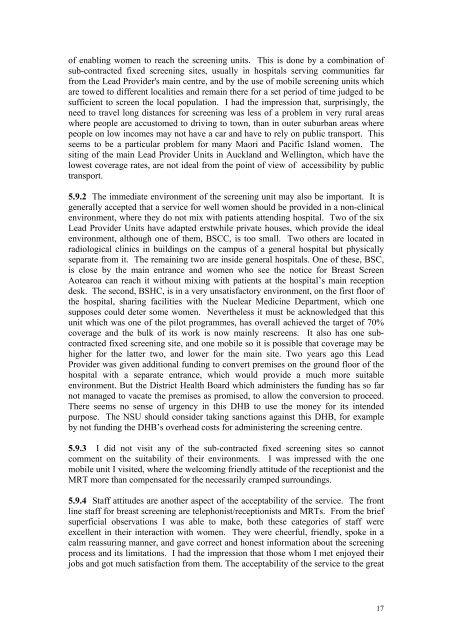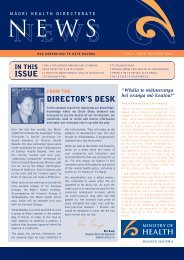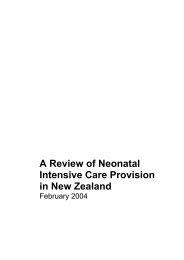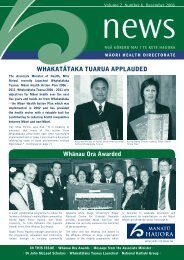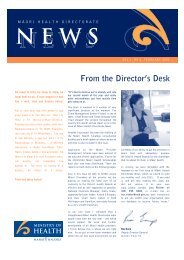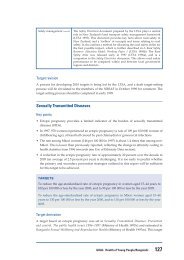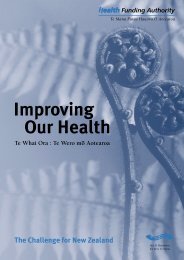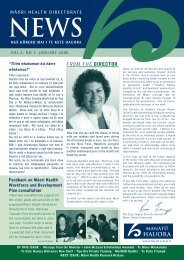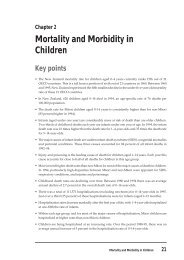breastscreen aotearoa an independent review - Ministry of Health
breastscreen aotearoa an independent review - Ministry of Health
breastscreen aotearoa an independent review - Ministry of Health
Create successful ePaper yourself
Turn your PDF publications into a flip-book with our unique Google optimized e-Paper software.
<strong>of</strong> enabling women to reach the screening units. This is done by a combination <strong>of</strong>sub-contracted fixed screening sites, usually in hospitals serving communities farfrom the Lead Provider's main centre, <strong>an</strong>d by the use <strong>of</strong> mobile screening units whichare towed to different localities <strong>an</strong>d remain there for a set period <strong>of</strong> time judged to besufficient to screen the local population. I had the impression that, surprisingly, theneed to travel long dist<strong>an</strong>ces for screening was less <strong>of</strong> a problem in very rural areaswhere people are accustomed to driving to town, th<strong>an</strong> in outer suburb<strong>an</strong> areas wherepeople on low incomes may not have a car <strong>an</strong>d have to rely on public tr<strong>an</strong>sport. Thisseems to be a particular problem for m<strong>an</strong>y Maori <strong>an</strong>d Pacific Isl<strong>an</strong>d women. Thesiting <strong>of</strong> the main Lead Provider Units in Auckl<strong>an</strong>d <strong>an</strong>d Wellington, which have thelowest coverage rates, are not ideal from the point <strong>of</strong> view <strong>of</strong> accessibility by publictr<strong>an</strong>sport.5.9.2 The immediate environment <strong>of</strong> the screening unit may also be import<strong>an</strong>t. It isgenerally accepted that a service for well women should be provided in a non-clinicalenvironment, where they do not mix with patients attending hospital. Two <strong>of</strong> the sixLead Provider Units have adapted erstwhile private houses, which provide the idealenvironment, although one <strong>of</strong> them, BSCC, is too small. Two others are located inradiological clinics in buildings on the campus <strong>of</strong> a general hospital but physicallyseparate from it. The remaining two are inside general hospitals. One <strong>of</strong> these, BSC,is close by the main entr<strong>an</strong>ce <strong>an</strong>d women who see the notice for Breast ScreenAotearoa c<strong>an</strong> reach it without mixing with patients at the hospital’s main receptiondesk. The second, BSHC, is in a very unsatisfactory environment, on the first floor <strong>of</strong>the hospital, sharing facilities with the Nuclear Medicine Department, which onesupposes could deter some women. Nevertheless it must be acknowledged that thisunit which was one <strong>of</strong> the pilot programmes, has overall achieved the target <strong>of</strong> 70%coverage <strong>an</strong>d the bulk <strong>of</strong> its work is now mainly rescreens. It also has one subcontractedfixed screening site, <strong>an</strong>d one mobile so it is possible that coverage may behigher for the latter two, <strong>an</strong>d lower for the main site. Two years ago this LeadProvider was given additional funding to convert premises on the ground floor <strong>of</strong> thehospital with a separate entr<strong>an</strong>ce, which would provide a much more suitableenvironment. But the District <strong>Health</strong> Board which administers the funding has so farnot m<strong>an</strong>aged to vacate the premises as promised, to allow the conversion to proceed.There seems no sense <strong>of</strong> urgency in this DHB to use the money for its intendedpurpose. The NSU should consider taking s<strong>an</strong>ctions against this DHB, for exampleby not funding the DHB’s overhead costs for administering the screening centre.5.9.3 I did not visit <strong>an</strong>y <strong>of</strong> the sub-contracted fixed screening sites so c<strong>an</strong>notcomment on the suitability <strong>of</strong> their environments. I was impressed with the onemobile unit I visited, where the welcoming friendly attitude <strong>of</strong> the receptionist <strong>an</strong>d theMRT more th<strong>an</strong> compensated for the necessarily cramped surroundings.5.9.4 Staff attitudes are <strong>an</strong>other aspect <strong>of</strong> the acceptability <strong>of</strong> the service. The frontline staff for breast screening are telephonist/receptionists <strong>an</strong>d MRTs. From the briefsuperficial observations I was able to make, both these categories <strong>of</strong> staff wereexcellent in their interaction with women. They were cheerful, friendly, spoke in acalm reassuring m<strong>an</strong>ner, <strong>an</strong>d gave correct <strong>an</strong>d honest information about the screeningprocess <strong>an</strong>d its limitations. I had the impression that those whom I met enjoyed theirjobs <strong>an</strong>d got much satisfaction from them. The acceptability <strong>of</strong> the service to the great17


